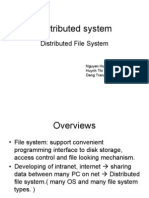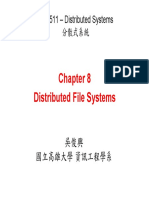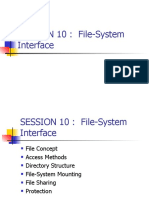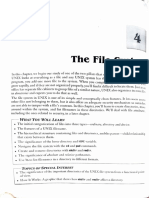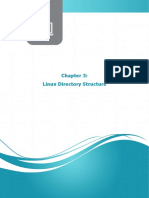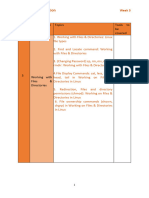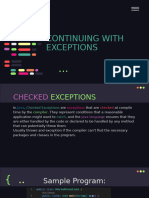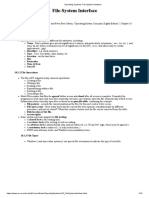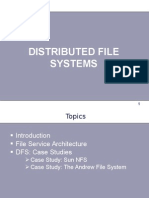DC 2 QA Unit III
DC 2 QA Unit III
Uploaded by
vr.aidCopyright:
Available Formats
DC 2 QA Unit III
DC 2 QA Unit III
Uploaded by
vr.aidCopyright
Available Formats
Share this document
Did you find this document useful?
Is this content inappropriate?
Copyright:
Available Formats
DC 2 QA Unit III
DC 2 QA Unit III
Uploaded by
vr.aidCopyright:
Available Formats
BUILDERS ENGINEERING COLLEGE, KANGEYAM
UNIT III
1. Enumerate the properties of storage system?
Sharing Persistent Distributed Consistency Example
cache/replicas maintenance
Main memory No No No 1 RAM
File system n No Yes No 1 UNIX file
system
Distributed file Yes Yes Yes Yes Sun NFS
system
web Yes Yes Yes No Web server
Distributed shared Yes No Yes Yes Ivy(DSM)
memory
Remote Yes No No 1 CORBA
objects(RMI/ORB)
Persistent object Yes Yes No 1 CORBA
store persistent state
service
Peer to peer storage Yes Yes Yes 2 Ocean Store
system
2. List out file system modules.
Directory module: Relates file names to file IDs
File module: Relates file IDs to particular files
Access control module: Checks permission for operation requested
File access module: Read or writes file data or attributes
Block module: Accesses and allocates disk blocks
Device module: Disk I/O and buffering
3. Sketch the file attributes and record structure.
File Length
Creation Time stamp
Read Timestamp
Write time stamp
Attribute time stamp
Reference count
Owner
File Type
Access control List
CS3551-DISTRIBUTED COMPUTING Page 1
BUILDERS ENGINEERING COLLEGE, KANGEYAM
4.List out the UNIX file system
Operations: fieldes=open(name,mode)
fieldes=create(name,mode)
status=close(fieldes)
count=read(fieldes,buffer,n)
count=write(fieldes,buufer,n)
pos=Iseek(filedes,offset,whence)
status=unlink(nmae)
status=link(name1,nmae2)
status=stat(name,buffer)
5. List out the transparencies in file system.
i. Access transparency
ii. Location transparency
iii. Mobility transparency
iv. Performance transparency
v. Scaling transparency
6. What is meant by concurrency control?
Changes to a file by one client should not interfere with the operation of other clients
simultaneously accessing or changing the same file. This is well-known issue of concurrency
control .The need for concurrency control for accss to shared data in many applications Is
widely accepted and techniques are known for its implementation ,but they are costly .Most
current file services follow morden UNIX standards in providing advisery or mandatoryfile or
record-level locking.
7. What is file replication?
In a file service that supports replication, a file may be represented by several copies of its
contents at different locations. This has two benefits-its enables multiple servers to share the load
of providing a service to clients accessing the same set of files, enhancing the scalability of the
service, and it enhances fault tolerance by enabling clients to locate another server that holds a
CS3551-DISTRIBUTED COMPUTING Page 2
BUILDERS ENGINEERING COLLEGE, KANGEYAM
copy of the file when one has failed. Few file services support replication fully, but most support
the catching of files or portions of files locally, a limited form of replication.
8. What is meant by directory services?
The directory services provide a mapping between text names for files and their UFIDs. Client
may obtain the UFIDs of a file by quoting its text name to the directory services. The directory
services provides the function needed to generate directories, to add new file name to directories
and to obtain UFIDs from directories. It is client of the flat file services; its directory is stored in
files of the flat services. When a hierarchic file-naming scheme is adopted as in UNIX,
directories hold references to other directories.
9.Sketch the file service architecture?
10. List the flat file service operation.
Read (file/d,I,N)>data-throws bad position - if 1 ≤ 1 ≤ length(file):reads a sequence of up to
N items From a file starting at item/and returns
it in data
Write(File/D,I,Ddata)-throws bad position - if 1 ≤ 1 ≤ length(file)+1: writes a sequence of
data to a File, starting at item 1,extending the file
if necessary
Create()->FileID -creates a new file of length 0 and delivers
a UFID for it
CS3551-DISTRIBUTED COMPUTING Page 3
BUILDERS ENGINEERING COLLEGE, KANGEYAM
Delete(FileID) -removes the file from the file store
GetAttributes(FileID)->> -returns the file attributes for the file
SetAttributes(FileID) -sets the file attributes(only those
attributes that not Shaded in)
11.List the directory service operation.
Lookup(Dir,Name)→FileID –throws not found Locate the text name in the directory and returns
the relevant UFID.If name is not in the
directory, throws an exception
AddName(Dir,Name,File) If the nameis not in the directory,
adds(Nmae,File) to the directory and updates
the file’s Attribute record.If name is already in
the Directory;throws an exception.
UnName (Dir,Name)—throws not found If name is in the directory: The entry containing
name is removed from the directory.
If name is not in the directory;throws an
exception.
GetName(Dir,Pattern)→Names Returns all the text names in the directory that
match the regular expression pattern.
12. Sketch NFS architecture.
CS3551-DISTRIBUTED COMPUTING Page 4
BUILDERS ENGINEERING COLLEGE, KANGEYAM
13. List the NFS file server operation.
Lookup(DirFH,Name)→FH,Attr Returns File handles and attributes for the File
Name in the directory DirFH.
Create(DirFH,Name,Attr)→NewFH,Attr Creates a new file in directory DirFH with
Attributes Attr and Returns the new File handle
and Attributes.
Remove(DirFH,Name) Status Removes file name from directory DirFH.
GetAttr(FH)→Attr Returns the file attributes of file FH.(similar to
UNIX stat system call)
Read(FH,Offset,count)→Attr,Dir Returns up to count bytes of data from the file
starting at the offset ,also return the attributes of
the file.
Write(FH,Offset,count,Data)→Attr Writes count bytes of to a file starting at
offset. Returns the attributes of the file after
write has taken place.
14. what are the timestamps in called caching?
i. Tc is the time when the cache entry was last validated.
ii. Tm is the when the block was last modified at the server.
iii. A cache entry is valid at time T if T-Tc is less than a freshness interval t,or if
the value for Tm recorded t the client matches the value of Tm at the server
(that is,the data has not been modified at the server since the cache entry
was made).
15.what is condition used to validate caching?
(T-Tc<t) v (Tm client=Tm server)
16.write the measures to be considered to reduce traffic in getattr.
Whenever a new value of Tmserver is received at a client, it is applied to all
cache entries derived from the relevant file.
The current attribute values are sent ‘piggybacked’ with the result of every
operation on a file, and if the value of Tmserver has changed the client uses it
to update the cache entries relating to the file.
CS3551-DISTRIBUTED COMPUTING Page 5
BUILDERS ENGINEERING COLLEGE, KANGEYAM
The adaptive algorithm for setting freshness interval t outlined above
reduces the traffic considerably for most files.
17. When the name is resolved?
The name is resolved when it is translated into data about the named resource or object, often in
order to invoke an action upon it. The association between a name and an object is called a
binding. In general, names are bound to attributes of the named objects, rather than the
implementation of the objects themselves. An attribute is the value of a property associated with
an object.
18. What is meant by URI?
URI-Uniform Resource Identifiers came about from the need to identify resources on the web,
and other internet resources such as electronic mailboxes. An important goal was to identify
resources in a coherent way, so that they could all be processed by common software such as
browser. URIs is ‘uniform’ in that their syntax incorporates that of indefinitely many individual
types of resource identifier(i.e URI schemas),and there are procedures for managing the global
namespace of schemas. The advantage of uniformity is that eases the process of introducing new
types of identifier, as well as using existing types of identifier in new contexts without
disrupting existing usage.
19. What is mean by URN?
Uniform Resource Names are URIs that are used as pure resource names rather than locators.
For example, the URI:
Mid:0E4FC272-5C02-11D9-B115-000A95B55BC8@hpl.hp.com
Is a URN that identifies the email message containing it in its ‘message-id’ field. The URI
distinguishes that message from any other email message. But it does not provide the message’s
address in any store, so a lookup operation is needed to find it.
20.What is global name services?
The Global name Service developed at the Digital Equipment corporation systems, Research
Center,is a descentdant of Grapevine with ambitious goals, including:
com- Commercial organization.
edu- universities and other educational institutions.
gov- US governmental agencies
mil- US military organization
net- major network support centers
org- organizations not mentioned above
CS3551-DISTRIBUTED COMPUTING Page 6
BUILDERS ENGINEERING COLLEGE, KANGEYAM
int – International oragnisations.
21. What is meant by navigation?
The process of locating naming data from than more than one name server in order to resolve a
name is called navigation. The client name resolution software carries out navigation on behalf
of the client. It communicates with name servers as necessary to resolve a name.
22. What is multicast navigation?
In multicast navigation, a client multicast the name to be resolved and required object type to the
group of name servers. Only the server that holds the named attributes responds to the request.
Unfortunately, however, if the name proves to be unbound, the request is greeted with silence.
23. What is iterative navigation?
One navigation model that DNS supports is known as iterative navigation. To resolve a name, a
client present the name to the local name server, which attempts to resolve it. If the local name
server has the name, it returns the result immediately. If it does not it will suggest another server
that will ba able to help. Resolution proceeds at the new server, with further navigation as
necessary until the name is located or is discovered to be unbounded.
24. What is meant by recursive and non recursive navigation?
In the non recursive and non recursive server controlled navigation. Under non recursive server
controlled navigation ,any name server may be chosen by the client. This server communicates
by multicast or iteratively with its peer in the style described above, as through it were a client.
Under recursive server-controlled navigation ,the client once more contacts a single server. If
this server doesnot store the name,the server contains a peer to storing a prefix of the
CS3551-DISTRIBUTED COMPUTING Page 7
BUILDERS ENGINEERING COLLEGE, KANGEYAM
name,which in turn attempts to resolve it. This procedure continues recursively until the name
resolved.
25. Write the disadvantage of existing name service?
This original scheme was soon seen to suffer from three major shortcomings:
It did not scale to large numbers of computers.
Local organization wished to administer their own naming system.
A general name service was needed- not one that serves only for looking up
computers address.
26. What is meant by DNS?
The domain name system is a name service design whose main naming database is used across
the internet. It was devised principally by mockapetris and specified in RFC 1034 and RFC
1035. DNS replaced the original internet naming scheme in which all host names and address
were held in a single central master file and downloaded by FTP to all computer that required
them.
Domain Names: The DNS is designed for use in multiple implementations, each of which may
have its own name space. In practice, however, only one is in widespread use, and that is one
used for naming across the internet. The internet DNS name space is partitioned both
organizationally and according to geography. The names are written with the highest-level
domain on the right. The original top-level organizational domains in use across the internet
were:
CS3551-DISTRIBUTED COMPUTING Page 8
BUILDERS ENGINEERING COLLEGE, KANGEYAM
27. What is meant by zone?
The DNS naming data are divided into zones. A zone contains the following data:
Attributes data for names in a domain, less any subdomains administrates by lower level
authorities.
The names and address of at least two name servers that provide authoritative data for the
zone. These are versions of zone data that can be relied upon as being reasonably up to
date.
The names of name servers that hold authoritative data for delegated sub domains; and
‘glue’ data giving the IP address of these servers.
Zone-management parameters, such as those governing the catching and replication of
zone data.
28. What is lookup operation?
29. List out options of NFS write operation?
Data in write operation received from client is stored in the memory cache at the server and
written to disk before a reply is sent to the client. This is called writethrough caching. The client
can be sure that is data stored persistently as soon as reply has been received.
Data in write operation is stored only in the memory cache. It will be written to disk when a
commit operation is received for the relevant file. The client can be sure that the data is persistent
stored only when a reply to a commit operation for the relevant file has been received. Standard
NFS clients use this mode of operation, issuing a commit whenever a file that was open for
writing is closed.
30. What is BIND implementation of DNS?
The Berkeley internet name domain is an implementation of the DNS for computers running
UNIX. Client programs link in library software as the resolver. DNS name server computers run
the named deamon. BIND allows for three categories of name server: primary server, secondary
yserver, caching only servers. The named program implements just one of these types, according
to the content of a configuration file. Caching only servers read in form a configuration file
sufficient names and address of authoritative servers to resolve any name. Thereafter, they only
store this data and data they learn by resolving names for clients.
31. Write the motivation openness?
Name management is separated from other service largely because of the openness of distributed
system, which brings the following motivation:
Unification
CS3551-DISTRIBUTED COMPUTING Page 9
BUILDERS ENGINEERING COLLEGE, KANGEYAM
Integration
32. Define name space.
A namespace is the collection of all valid names recognized by a particular service. The service
will attempt to look up a valid name, even though that name may prove not to correspond to any
object. Name space requires a syntactic definition to separate.
PART B
1. Discuss in details file service architecture
An architecture that offers a clear separation of the main concerns in providing
access to files is obtained by structuring the file service as three components – a flat file
service, a directory service and a client module.
The division of responsibilities between the modules can be defined as follows:
Flat file service: The flat file service is concerned with implementing
operations on the contents of files.
Directory service: The directory service provides a mapping between text
names for files and their UFIDs.
Client module: A client module runs in each client computer, integrating
and extending the operations of the flat file service and the directory
service under a single application programming interface that is available
to user-level programs in client computers.
2. Explain in detail about napster and its legacy
The first application in which a demand for a globally scalable information
storage and retrieval service emerged was the downloading of digital music files.
Napster’s architecture included centralized indexes, but users supplied the files,
which were stored and accessed on their personal computers.
Limitations: Napster used a (replicated) unified index of all available music files. For the
application in question, the requirement for consistency between the replicas was not
strong, so this did not hamper performance, but for many applications it would constitute
a limitation. Unless the access path to the data objects is distributed, object discovery and
addressing are likely to become a bottleneck
CS3551-DISTRIBUTED COMPUTING Page 10
BUILDERS ENGINEERING COLLEGE, KANGEYAM
Application dependencies
• Music files are never updated, avoiding any need to make sure all the replicas of files
remain consistent after updates.
• No guarantees are required concerning the availability of individual files – if a music
file is temporarily unavailable, it can be downloaded later. This reduces the requirement
for dependability of individual computers and their connections to the Internet.
3. Explain the name caches in details
Characteristics:
High degree of locality of name lookup
Slow update of name information database
On-use consistency of cached information
Types of name Caches
Directory cache
Prefix cache
Full name cache
Name cache implementation
A cache per process
A single cache for all process of a node.
Multicache consistency
Immediate Invalidate
On-Use Update
4. Illustrate routing overlays
The routing overlay ensures that any node can access any object by routing each
request through a sequence of nodes, exploiting knowledge at each of them to locate the
destination object. Peer-to-peer systems usually store multiple replicas of objects to
ensure availability.
The main task of a routing overlay is the following:
Routing of requests to objects
Insertion of objects
Deletion of objects
Node addition and removal
CS3551-DISTRIBUTED COMPUTING Page 11
BUILDERS ENGINEERING COLLEGE, KANGEYAM
5. Describe LDAP
LDAP stands for Lightweight Directory Access Protocol Access Protocol. LDAP
defines a standard method for accessing and updating information in a directory.
LDAP uses:
Centrally manage users, groups and other data
Don’t have to manage separate directories for each application
Allows users to find data that they need.
Not locked into a particular server.
LDAP is well suited for
Information that is referenced by many entities and applications
Information that needs to be accessed from more than one location
Information that is read more often than it is
written LDAP is not well suited for
Information that changes often.
Information that is unstructured.
CS3551-DISTRIBUTED COMPUTING Page 12
You might also like
- Unit Iii 1. Enumerate The Properties of Storage System?Document10 pagesUnit Iii 1. Enumerate The Properties of Storage System?avishanaNo ratings yet
- Distributed File SystemsDocument25 pagesDistributed File Systemsdaica1988No ratings yet
- Distributed File SystemsDocument38 pagesDistributed File SystemsManziniLeeNo ratings yet
- Dos 1Document59 pagesDos 1acercNo ratings yet
- Ch9 FilesystemsDocument52 pagesCh9 FilesystemsKevin MhutsiwaNo ratings yet
- Unit - Iii: Prepared by N.Susila Ap/It SkcetDocument66 pagesUnit - Iii: Prepared by N.Susila Ap/It SkcetKousi KrishNo ratings yet
- Unit 6: File-System InterfaceDocument43 pagesUnit 6: File-System Interfacetejaswini patilNo ratings yet
- UNIT 5- FILE SYSTEM INTERFACEDocument15 pagesUNIT 5- FILE SYSTEM INTERFACEbenazirrose2704No ratings yet
- Chapter 8Document30 pagesChapter 8KaranNo ratings yet
- Operating SystemDocument36 pagesOperating SystemAdi SeshuNo ratings yet
- Module 5Document46 pagesModule 5Manju M CSENo ratings yet
- Distributed File Systems: Pertemuan Ke 8Document19 pagesDistributed File Systems: Pertemuan Ke 8aprilian13No ratings yet
- 10 File SystemDocument30 pages10 File SystemPrajwal KandelNo ratings yet
- Chapter 1Document24 pagesChapter 1Firas BadroNo ratings yet
- Course MaterialDocument23 pagesCourse MaterialsumipriyaaNo ratings yet
- Unit 2. Sun Network File System.Document1 pageUnit 2. Sun Network File System.mrharan657No ratings yet
- CH 10Document43 pagesCH 10JeronimoNo ratings yet
- Filesho 4Document11 pagesFilesho 4Shyam VenkataramanNo ratings yet
- Distributed File SystemsDocument46 pagesDistributed File SystemsFrank OyugiNo ratings yet
- Operating Systems Unit-4Document21 pagesOperating Systems Unit-4Atharv JoshiNo ratings yet
- File System ManipulationDocument2 pagesFile System ManipulationRobert FavourNo ratings yet
- Chapter 12 SlidesDocument17 pagesChapter 12 SlidesMuhammad FarooqNo ratings yet
- Chapter 11: Distributed File SystemsDocument6 pagesChapter 11: Distributed File SystemsgopitheprinceNo ratings yet
- Unit IV Fundamental File Processing Unit IV Fundamental File Processing OperationsDocument39 pagesUnit IV Fundamental File Processing Unit IV Fundamental File Processing Operationsduvvuru familyNo ratings yet
- Adobe Scan 02 Jan 2023Document17 pagesAdobe Scan 02 Jan 2023priyanka G MNo ratings yet
- File SystemsDocument86 pagesFile SystemsNhungNo ratings yet
- OS - Chapter - 5 - File SystemDocument30 pagesOS - Chapter - 5 - File Systemktesfaneh2No ratings yet
- OS Unit - 5 NotesDocument34 pagesOS Unit - 5 NoteshahahaNo ratings yet
- Computer Organization and Operating Systems - U5Document16 pagesComputer Organization and Operating Systems - U5Vanam SaikumarNo ratings yet
- Linux Crash Course: Command Description Filesystem / PWD - ..Document5 pagesLinux Crash Course: Command Description Filesystem / PWD - ..angelviNo ratings yet
- pr2 Eng TTY 24 c5Document44 pagespr2 Eng TTY 24 c5sonyasovushka1212No ratings yet
- Lect Note On Chapter 4 - Part I - File I-ODocument25 pagesLect Note On Chapter 4 - Part I - File I-Obeshahashenafi32No ratings yet
- Chapter 6 - File SystemDocument41 pagesChapter 6 - File SystemThe True TomNo ratings yet
- 1 File Management: 1.1 NamingDocument10 pages1 File Management: 1.1 Namingpaul mulwaNo ratings yet
- File SystemsDocument17 pagesFile SystemsParvinder vidanaNo ratings yet
- 06 Files DirectoriesDocument5 pages06 Files Directoriesemnet81No ratings yet
- Inputoutput Files User ManagementDocument11 pagesInputoutput Files User ManagementEszterNo ratings yet
- Oracle Linux: Cheat SheetDocument5 pagesOracle Linux: Cheat Sheetkvigneshk2001No ratings yet
- Os Lesson 3 File ManagementDocument9 pagesOs Lesson 3 File Managementmichellegichuhi94No ratings yet
- File Management 1Document11 pagesFile Management 1Aniket pandeyNo ratings yet
- Linux Directory StructureDocument28 pagesLinux Directory StructurefdsaaNo ratings yet
- Cit381 Calculus Educational Consult 2021 - 1Document43 pagesCit381 Calculus Educational Consult 2021 - 1Temiloluwa IbrahimNo ratings yet
- Ulp Viva QuestionsDocument7 pagesUlp Viva QuestionssoniaNo ratings yet
- DFSNov 1Document36 pagesDFSNov 1Taha KarimNo ratings yet
- Week Broader Topic Topics Tools To Be Covered: Linux System AdministrationDocument10 pagesWeek Broader Topic Topics Tools To Be Covered: Linux System AdministrationVarinder DhillonNo ratings yet
- File Input and OutputDocument38 pagesFile Input and OutputKenneth ViovicenteNo ratings yet
- He-Dieu-Hanh - Kai-Li - Filelayout - (Cuuduongthancong - Com)Document7 pagesHe-Dieu-Hanh - Kai-Li - Filelayout - (Cuuduongthancong - Com)ng.tuandungcsNo ratings yet
- Theory Assignment 01Document13 pagesTheory Assignment 01Pradip SarkerNo ratings yet
- File SystemDocument37 pagesFile SystemZainab HameedNo ratings yet
- File System-1Document11 pagesFile System-1Leslie QwerNo ratings yet
- Operating Systems - File-System InterfaceDocument13 pagesOperating Systems - File-System InterfaceSAI PAVANNo ratings yet
- Unit5files 200527135233Document30 pagesUnit5files 200527135233Assad LeoNo ratings yet
- CNS 320 Week10 Final ReviewDocument94 pagesCNS 320 Week10 Final Reviewalb3rtlinNo ratings yet
- 5 Distributed File SystemDocument59 pages5 Distributed File SystemsaiprashantNo ratings yet
- CSI3131Mod9FileSysDocument89 pagesCSI3131Mod9FileSysJohnNo ratings yet
- UNIX Quick Reference Sheet: 2.4 Comparing FilesDocument4 pagesUNIX Quick Reference Sheet: 2.4 Comparing FilesSimran SinghNo ratings yet
- Chapter 6 File SystemDocument9 pagesChapter 6 File SystemDaya Ram BudhathokiNo ratings yet
- 04 - Permanent Storage (Unit Review)Document2 pages04 - Permanent Storage (Unit Review)sansNo ratings yet
- Distributed File SystemsDocument56 pagesDistributed File SystemsMadhavi HosurNo ratings yet

